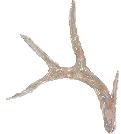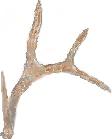Kerr WMA: Deer Research Results
Role of Genetics in Antler Development: 1974-1994 (790 deer, 566 sets of antlers)


In this study, male deer that were spikes as yearlings (1.5 years of age) were placed in an individual pen and bred to a group of does. There were seven spike sires used throughout the study. The male deer were then bred to their daughters to concentrate the gene pool of the sires. The original does (those that were originally bred to the deer that were spikes as yearlings) were then bred to a large antlered male that had six points as a yearling. There was a significant difference in progeny antler production between the three types of matings. The results of these matings strongly indicated a genetic role in antler development. All deer throughout this study were fed a free choice 16% protein diet. Nutrition was not a factor. This study is also reported in the 1989 Texas Parks and Wildlife bulletin, Effects of Genetics and Nutrition on Antler Development and Body Size of White-tailed Deer (PDF 945 KB).
(PDF 945 KB).